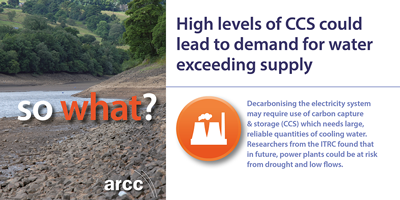As part of the Infrastructure Transitions Research Consortium (ITRC), researchers at Newcastle, Cardiff and Oxford Universities studied the dependency of power generation on water resources. In a future with high levels of carbon capture and storage (CCS), the demands for cooling water may exceed supply during droughts.
Currently, thermal power stations in the UK are responsible for about 5% of the UK’s freshwater use. Population growth and climate change are expected to put pressure on water resources, while decarbonising the electricity system will require low-carbon technologies such as nuclear power, CCS and renewables – some of which require reliable cooling water sources to function. This study examined the amount and availability of water required for future electricity systems.
Relevance
To maintain security of supply, thermal power stations such as nuclear, coal and gas, and power plants with CCS, require reliable water sources to cool steam.
Freshwater is often used in large quantities. In a large (1GWe) coal power plant, as much as 1 m3 of water is continuously lost to evaporation, every second. Most of the time this is not a problem.
This dependency on water is particularly critical during low flows and drought. Water users may be ask to reduce consumption which could limit output from the power plant.
Carbon capture and storage is a promising technology that could reduce carbon dioxide emissions from power stations by as much as 90%. However, it is expected to increase the plant water demands by 40–90%.
Findings
Freshwater use by the sector is decreasing, and will continue to do so if the future electricity system is powered by renewables and nuclear power.
However, in a future with high levels of CCS:
- Total freshwater demands could be as much as double the current levels.
- The demands are likely to be concentrated in the North West, East Midlands and Humber regions.
- During droughts and low flows under medium emissions climate projections, demands from the electricity sector are likely to exceed the available water resource, putting power supplies at risk.
Now what?
With a likely water-scarce future in the UK, we must ensure that this does not have an impact on the security of water supply for the electricity sector.
An electricity system that is highly dependent on water is vulnerable to prolonged drought, with potentially severe consequences. In the past 15 years, both France and Brazil have twice faced electricity shortages due to droughts. Approximately a third of the UK’s power plants currently use freshwater for cooling.
Diversity of supply
Diversity of electricity supply can mitigate water and climate change risks. A system with high levels of non-thermal renewables and/or nuclear cooled by sea water, will be resilient to water-related risks.
Cooling systems
Hybrid and dry cooling systems reduce power plant water use, but are more costly to install and operate.
Cooling sources
A variety of water sources can be used. Sea, brackish and even treated waste water are also suitable for cooling in water-scarce regions.
Fuel type and efficiency
The more efficient the power plant, the less cooling water is required. Gas plants are more thermally efficient than coal, subsequently using less water. Moving away from coal could halve water use.
CCS clusters
CCS will probably be developed in clusters of power plants to reduce infrastructure costs. This means the associated 40–90% likely increase in water demand will also be spatially concentrated.
- Regional planning of CCS clusters can ensure there is sufficient cooling water.
- New power plants in the EU must be Carbon Capture Ready; ready to implement CCS if it becomes commercially viable. Newly consented power plants should ensure that water resource will be available if CCS is installed at a later date.
- Reducing water and climate risks to CCS can lower costs for this important, but currently expensive, emerging technology.


